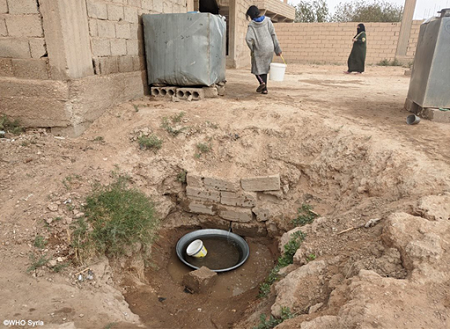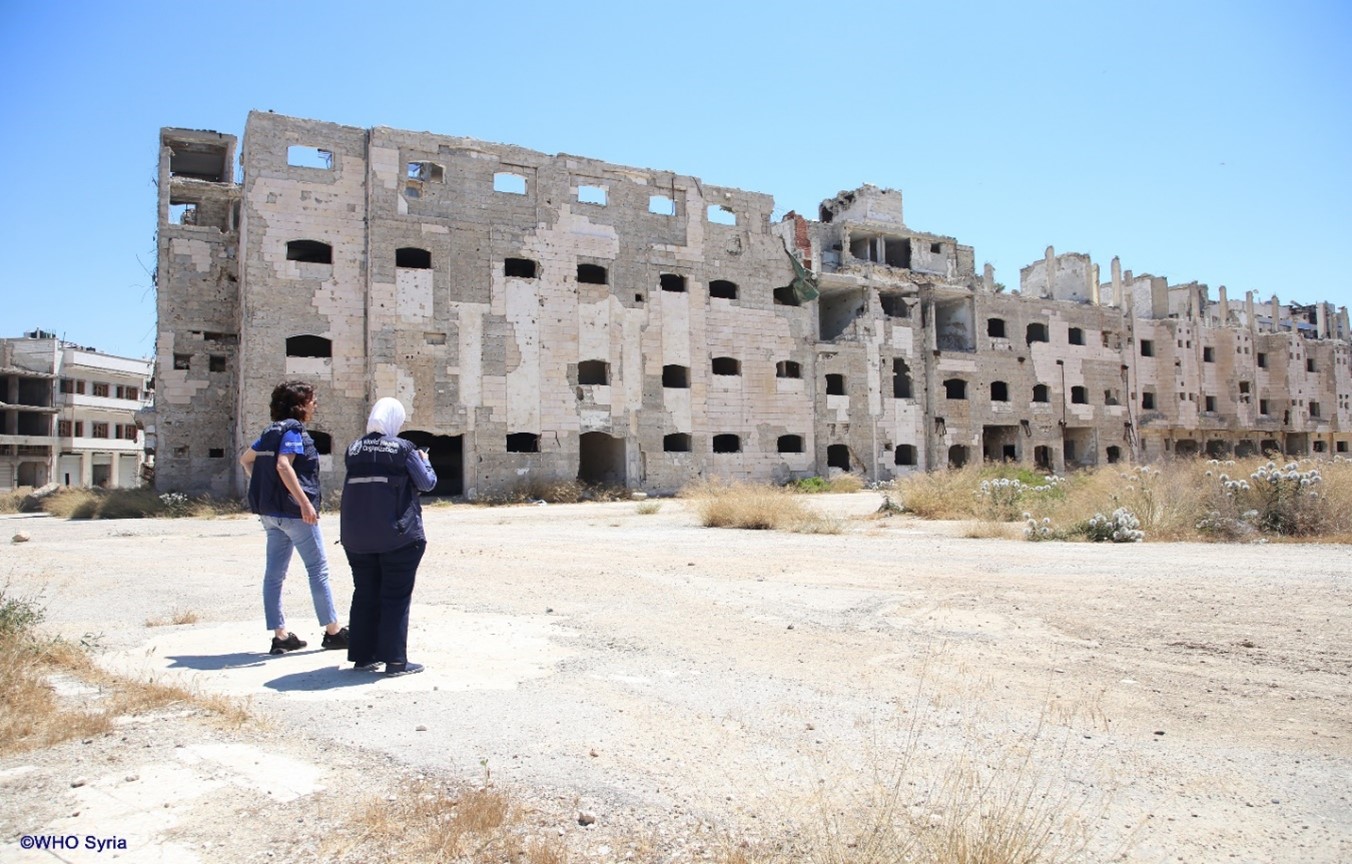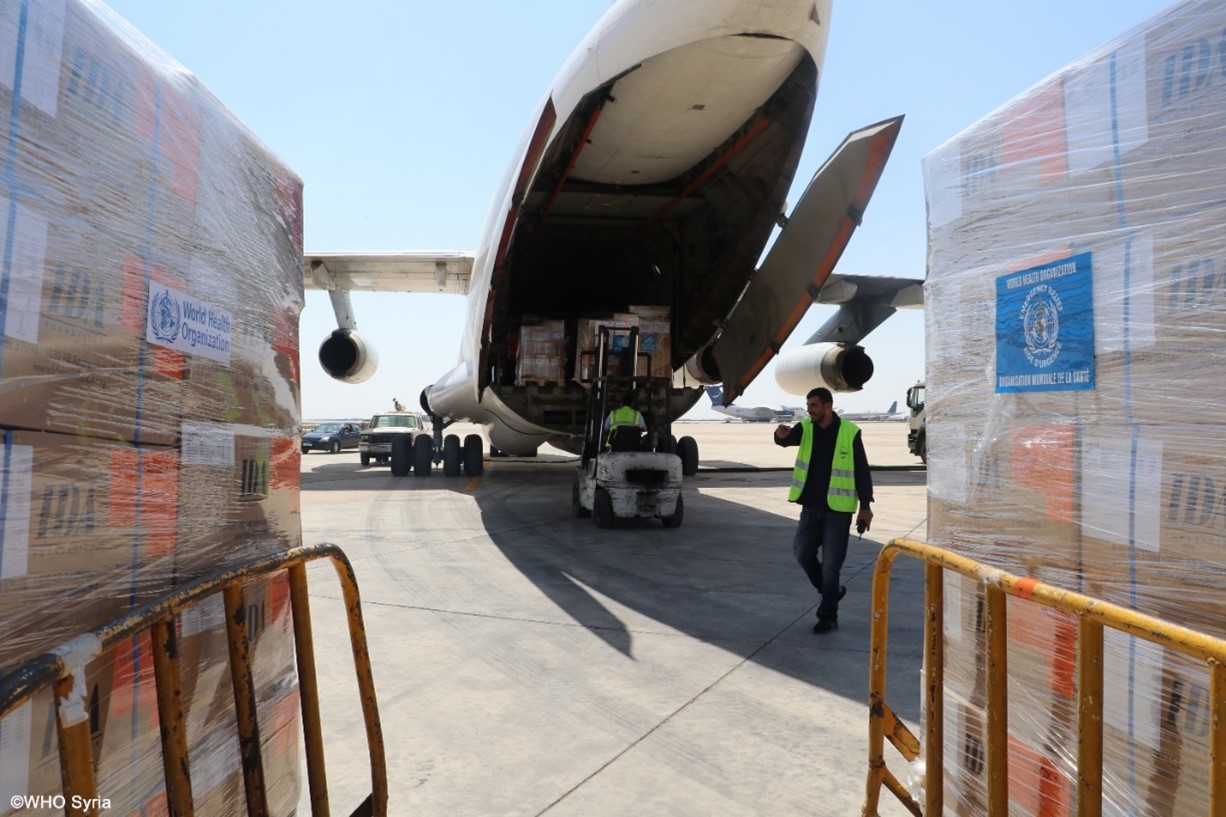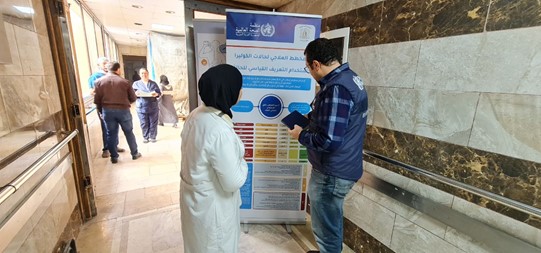8 December 2022 – Since the first case was declared on 6 September 2022, cholera has spread to all 14 governorates in Syria, adding another grim chapter of human suffering in the war-torn country.
Between 25 August and 26 November 2022, over 52 013 suspected cholera cases and 98 deaths were reported across Syria, with Deir-ez-Zor, Ar-Raqqa, Aleppo, Idleb, and Al-Hasakeh, reporting the highest figures. Camps hosting internally displaced people (IDPs) have reported more than 2100 cases.
“I was about to die, I felt weak and without strength. My condition was deteriorating with hours of diarrhoea and vomiting. I could only go to the nearest pharmacy since no health centres or hospitals exist in my village,” said Salem, a 35-year-old man from Al-Kubar village in rural Deir-ez-Zor.
 Poor water resources in rural Deir-ez-Zor governorate. WHO/Syria“I was so worried about my condition; I was lying on the ground for 4 hours connected to IV fluids,” continued Salem. “The pharmacist immediately notified the WHO-supported EWARS focal point who suspected that I was cholera-positive and facilitated my journey to the nearest hospital in Al-Kesra city to receive the necessary medical treatment.”
Poor water resources in rural Deir-ez-Zor governorate. WHO/Syria“I was so worried about my condition; I was lying on the ground for 4 hours connected to IV fluids,” continued Salem. “The pharmacist immediately notified the WHO-supported EWARS focal point who suspected that I was cholera-positive and facilitated my journey to the nearest hospital in Al-Kesra city to receive the necessary medical treatment.”
With a combination of ongoing hostilities, widespread destruction of the infrastructure, deprivation of essential health services, and a substantial number of IDPs, in addition to a climatic-induced and human-caused shocks affecting natural resources – particularly water; cholera is back in Syria for the first time since 2009.
The provision of safe water for millions of Syrians has slowly been reduced, in addition to the destructed water infrastructure, combined with record-low water levels in the Euphrates River.
Strained health system ravaged by cholera
Eleven years of conflict, socioeconomic downturn, population displacement, and multiple public health hazards, including disease outbreaks, have put significant pressure on a fragmented health system in Syria.
“Nearly 30% of all public health facilities in Syria remain non-functional and unable to respond to the growing health needs,” says Dr Iman Shankiti, WHO a.i. Representative in Syria. “People of Syria have been trying hard for years to just survive, cholera threat is a very unwelcome nightmare for millions.”
A chronic shortage of health care staff is another inevitable challenge. In addition, suboptimal living conditions and limited access to basic health services, particularly in overburdened communities and camps/sites with internally displaced persons, have increased the risk of exposure to disease outbreaks.
The essential health service infrastructure requires extensive maintenance and rehabilitation to provide a minimum level of service delivery.
 Destroyed health facility in Homs governorate “Homs National Hospital”. WHO Syria
Destroyed health facility in Homs governorate “Homs National Hospital”. WHO Syria
The whole of Syria’s approach to the cholera response
With funding from the United Nations Office for the Coordination of Humanitarian Affairs (OCHA), the Central Emergency Response Fund (CERF), Italy, Norway, and the Global Alliance for Vaccine and Immunization (GAVI), WHO is supporting health authorities and other humanitarian partners to respond to the outbreak by implementing a multisectoral approach to control the outbreak, scaling up surveillance and testing capacity, training healthcare workers, promoting awareness among the population, and monitoring water quality in high-risk areas.
WHO has activated the incident management coordination systems in Damascus and Gaziantep and the Cholera Task Force in Gaziantep and northeast Syria to work closely with the Whole of Syria Coordination Cell, particularly on surveillance and active case-finding.
“While we’re extremely concerned about the cholera spike in the country, a coordinated approach by government, partners, and communities can bring this outbreak under control,” says Dr Shankiti.
Since the first case was declared on 6 September, WHO has delivered a 60-tonne shipment of cholera kits, oral rehydration solutions, rapid diagnostic tests, and medical supplies for intravenous (IV) rehydration treatment, in addition to chlorine for water purification. WHO also provided 3.5 million aqua tabs to the directorates of health for wider distribution within their respective governorates.
 Responding to the cholera outbreak in Syria, WHO delivered a 60-tonne shipment of cholera kits, oral rehydration solutions, rapid diagnostic tests, and medical supplies for intravenous (IV) rehydration treatment, in addition to chlorine for water purification. C: WHO SyriaIn addition, a shipment of 2 million doses of oral cholera vaccines funded by GAVI arrived in Damascus on 29 November 2022. The vaccines will be used in an immunization campaign in 4 governorates of Al-Hasakeh, Deir-ez-Zor, Ar-Raqqa, and Aleppo targeting populations above one year of age in areas where the disease is spreading fast, and communities have limited access to health facilities, clean water, and sanitation.
Responding to the cholera outbreak in Syria, WHO delivered a 60-tonne shipment of cholera kits, oral rehydration solutions, rapid diagnostic tests, and medical supplies for intravenous (IV) rehydration treatment, in addition to chlorine for water purification. C: WHO SyriaIn addition, a shipment of 2 million doses of oral cholera vaccines funded by GAVI arrived in Damascus on 29 November 2022. The vaccines will be used in an immunization campaign in 4 governorates of Al-Hasakeh, Deir-ez-Zor, Ar-Raqqa, and Aleppo targeting populations above one year of age in areas where the disease is spreading fast, and communities have limited access to health facilities, clean water, and sanitation.
Working in 51 hospitals designated for cholera treatment and 96 health centers for oral rehydration, WHO has actively provided 100 training courses in all 14 governorates across the country. More than 2 500 health professionals working in public and private health facilities were trained on cholera standard case definition, case management, and infection prevention and control.
Currently, WHO provides operational support to 101 rapid response teams at the central and governorate levels.
In northwest Syria, WHO supported 6 cholera treatment centres, which are now fully functional with a 126-bed capacity and three functional oral rehydration points, while another 11 centres are being equipped.
In northeast Syria, WHO continues to support the cholera treatment centres, including distributing more than 30 tonnes of supplies (cholera kits, aqua tabs, and medical supplies); capacity-building training courses for 200 health care workers on case management; active surveillance by daily visits to public and private hospitals, in addition to a continuous intensified water testing efforts.
“Cholera isn’t a common disease in Syria, and since the beginning of the outbreak, capacity-building training courses have been conducted for doctors and medical personnel in coordination with WHO, in addition, WHO supported the preparation of cholera treatment unit in the hospital,” says Dr Bassel Zyno, Director of Zahi Azrak Hospital in Aleppo.
 Zahi Azrak Hospital in Aleppo, a treatment centre for cholera. WHO/Syria “The difficulties lie in the increasing number of cases, the unpredictability of disease spread to new areas, and the large consumption of intravenous fluids, medicines, and medical supplies which led to a shortage of these supplies and consumables. Currently, in cooperation with the concerned health authorities and partners, our job is to secure them.”
Zahi Azrak Hospital in Aleppo, a treatment centre for cholera. WHO/Syria “The difficulties lie in the increasing number of cases, the unpredictability of disease spread to new areas, and the large consumption of intravenous fluids, medicines, and medical supplies which led to a shortage of these supplies and consumables. Currently, in cooperation with the concerned health authorities and partners, our job is to secure them.”
Additionally, and as part of raising awareness about cholera, WHO and other health partners, including hygiene promoters, community mobilizers, health workers, and camp managers, reached more than 700 000 individuals with key messages on cholera prevention and control. More than 287 000 information, education, and communication (IEC) materials have also been distributed.
Key priorities while moving forward
While response activities continue, WHO and its partners require increased support to adequately fund cholera response plan activities across Syria and provide opportunities for scale-up, particularly regarding rehabilitation, construction, and maintenance of water structures and procurement of medical supplies for cholera management.




